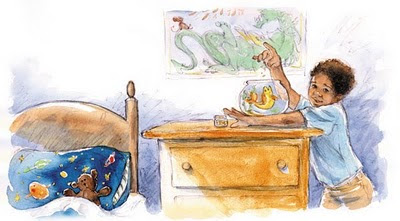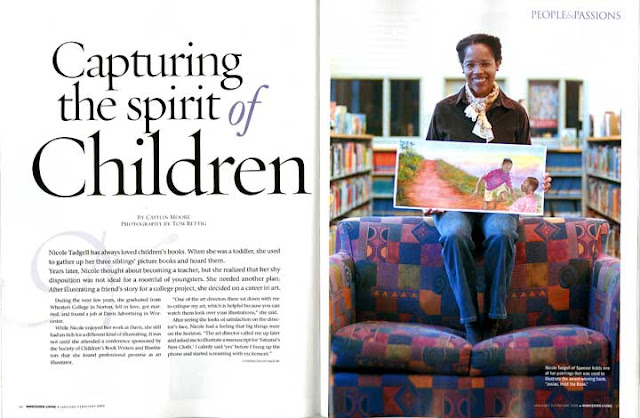Booklist
Gr. 1-3. Josias lives in Haiti, where the people are poor and school is not always a possibility. It's Josias' job to care for the garden where his family grows sweet potatoes and peas. On their way to school, children ask him, "Josias, when will you hold the book?" But Josias knows he has no time for schooling. When the garden begins to fail, he tries adding first water, then dung, but nothing works. Then he has an idea. Perhaps the answer is somewhere in a book. A schoolteacher helps him with a book that explains that because the soil is tired, Josias must change crops. Now, Josias' father sees school as a good idea, though the boy's attendance will be a hardship. U.S. readers will get insight into a different culture, where poverty holds people back and schooling is a privilege--one that can make all the difference. Another interesting aspect of the story is that a child is helping lead his parents into modernity. The narrative is effective, but the pale watercolors take some of the intensity from a very different sort of story. Ilene Cooper
Copyright © American Library Association. All rights reserved.
Kirkus Reviews
On his Haitian farm, young Josias struggles to develop his bean crop that doesn't seem to want to grow this year. Seeing his friend Chrislove walk by on his way to school, Josias refuses the daily invitation to attend and "hold the book," noting his more important role, in a joint effort to earn a living as the family's vegetable gardener. Each successive day of frustration over the lack of a bean crop results in hours of thinking and trials of providing extra water and donkey dung for fertilizer. Josias finally comes to the realization that a book might provide a working solution. Now Josias must convince his father that school will serve an important purpose in the family's livelihood. Elvgren effectively portrays the dilemma faced by a majority of small agrarian families in an impoverished and predominantly illiterate rural society. Soft watercolors in muted shades of blues and greens offer the simple beauty of the countryside. Josias's well-meaning, earnest behavior comes through in several expressive facial portrayals as he thinks about solutions to his problem. Despite the difficulties, Elvgren presents a positive look at a struggling part of the world. (author's note) (Picture book. 5-8)
School Library Journal
ELVGREN, Jennifer Riesmeyer. Josias, Hold the Book. illus. by Nicole Tadgell. unpaged. CIP. Boyds Mills. Mar. 2006. RTE $15.95. ISBN 1-59078-318-2. LC 2005024989.
Gr 1-3-When the beans in Josias's garden won't grow, he must find a solution or his family will not have enough to eat. He tries giving the plants extra water and manure, to no avail. He asks a friend who is lucky enough to "hold the book" (attend school) if the answer might be found in a book. What Josias learns convinces him to ask his parents if, in addition to tending the garden, he can go to school. Elvgren has crafted a matter-of-fact snapshot of rural Haitian life. Tadgell's muted watercolor spreads set the tone and enhance the text. Emotions are clearly depicted, giving the characters added dimension and believability. An author's note gives a detailed account of why rural Haitians often don't attend school and of a typical primary-school day.-Catherine Callegari, Gay-Kimball Library, Troy, NH
Library Media Connection - November/December 2006
A young Haitian boy has a problem to solve and he finds the answer when he learns to read. Josias and his family live in rural Haiti. They eke out a living by growing beans, other vegetables, and fruit. Josias is responsible for a plot of land and does not attend school. His friends pass by on their way to class chanting "Josias, when will you hold the book?" a colloquialism for "when will you go to school?" One year, the beans n Josias' garden will not grow. He asks his friends if books could help him get his beans to grow. His friend Chrislove returns from school with a book about gardening, but Josias cannot read it. He convinces his father to let him go to school to learn to read so that he can understand how to make the crops grow better. This is a delightful story with illustrations that are like fine watercolor paintings, and text that is written in a flowing, gentle, almost poetic manner. This is a terrific book to use as a springboard for reading motivation as well as for Social Studies. The author's note at the end explains the economic and social structure of rural Haitian society. Recommended. Karen Sebesta, Educational Reviewer, San Antonio, Texas
Heritagekonpa Magazine
By Tequila Minsky
Trying to solve two problems: beans that won’t grow and a desire to go to school in the children’s book, Josias, Hold The Book
Sixteen lush double page watercolor illustrations and accompanying text tell a boy's story of work, problem solving, and desire to go to school. Set in rural agricultural Haiti, "Josias, Hold The Book" by Jennifer Riesmeyer Elvgren will be published in March.
Illustrator Nicole Tadgell spent 6 months doing research and rough sketches so her double page illustrations would be accurate; the luminous images are a joy. Josias works barefoot in his garden in a landscape dotted with a few banana trees and distant mountains.
The earth is red and for those familiar with Haiti it conjures images of the mountains of Kenskoff and above where vegetables are grown for Port-au-Prince but it's not site specific; it could be in many regions.
Josias waters his garden from a big white plastic bucket; his sister carries a red jug for water. The children wear shoes and colorful uniforms to school--appropriately red and blue( the color of the Haitian flag ). Laundry is draped over the line, no clothespins.
Everyone contributes to the livelihood of Josias' family who live in the agricultural countryside; Josias spends his days tending his garden. As children pass on their way to school his friend greets him and asks, "When will you join us and hold the book?"
Josias observes that this year the beans he's planted-as usual, been between rows of sweet potatoes and peas- are not growing, the problem that needs to be resolved.
Josias references his father's successful gardening techniques to solve the situation and through these attempts a picture of rural life is revealed. Josias and his sisters walk a mile to get more water; he adds extra donkey dung to the garden. As each attempt is unsuccessful Josias wracks his brain for a solution to get the beans to grow. Each day his friend passes on the way to school asking, "When will you hold the book?"
When one of the schoolchildren drops an armful of books along the road it triggers a new possible solution, "maybe books can tell me how to make my beans grow." His friend agrees to ask Teacher who sends home a book with pictures of fruits and vegetables he'd never seen. His friend explains, "The book says that the soil all over Haiti is tired...you need to plant the beans in a different spot and plant something else where the beans were."
Josias must then tell his father about the problem, possible solution, and his desire to "hold the book."
Much is revealed: the agricultural rural family as a working unit, school as a privilege not a given, environmental issues. More subtle: girls are in the background–definitely a Haitian reality. (But, there are changes even in this.)
The small details are illustrative while exploring the pictures. Trees are few. Long mounds of soil make up the garden beds. Mother cooks in a large pot on an open flame. When Josias finally goes to school he wears his shoes.
This book adds to the very small number of children's books depicting life in Haiti and can add as a jumping off point to talk about how life is in the countryside and how different it is from American life. It reveals family priorities, working together for survival and speaks to the sacrifices made to get an education. It also points to patriarchal family structure.
The main subject Josias' best friend is named Chrislove. Janine Anis, retired New York City educator and initiator of the Bilingual (Haitian-Creole/English) program in the New York schools commented that it is a good story which she would buy and would have great value for bilingual students and can help validate the experience of the emigrant. However, she did observe that the secondary character's name, Chrislove, though it exists, is not a typical Haitian name-she had never heard it before- and appears to be an English name. Furthermore, there might be issues: use of this name could be construed as having religious connotations. It is unfortunate that the author chose this name for the secondary character. Educator Lily Cerat felt more strongly that there is a religious subtext: Chrislove, the Book.
A children's librarian for the New York Public Library commented that it's usually adults who react to names and draw possible connotations, children don't. Though the book is targeted for ages 6-9, its greatest value, she believes is if an adult who can add context and explanation to the story of children whose lives are so different from their own introduces it.
Ms. Cerat also took issue when Josias says the line, "I have no use for reading and writing when there is a garden to weed." She commented, "Even poor Haitians have a great respect for education."
There are so few English children’s books about Haiti available that book professionals, educators, and the librarian agreed that a book illustrated as it is so beautifully, adds to the highly limited selection of books about this region. Its value also is as a jumping point for discussion with adults about the relationship with parents, the role of education, and how different or not are other cultures.
The author, Jennifer Riesmeyer Elvgren, has sponsored children in Haiti. Nicole Tadgell has illustrated a number of children’s books and won the Africana Book Award for Fatuma’s New Cloth, about a girl in Tanzania.



















































